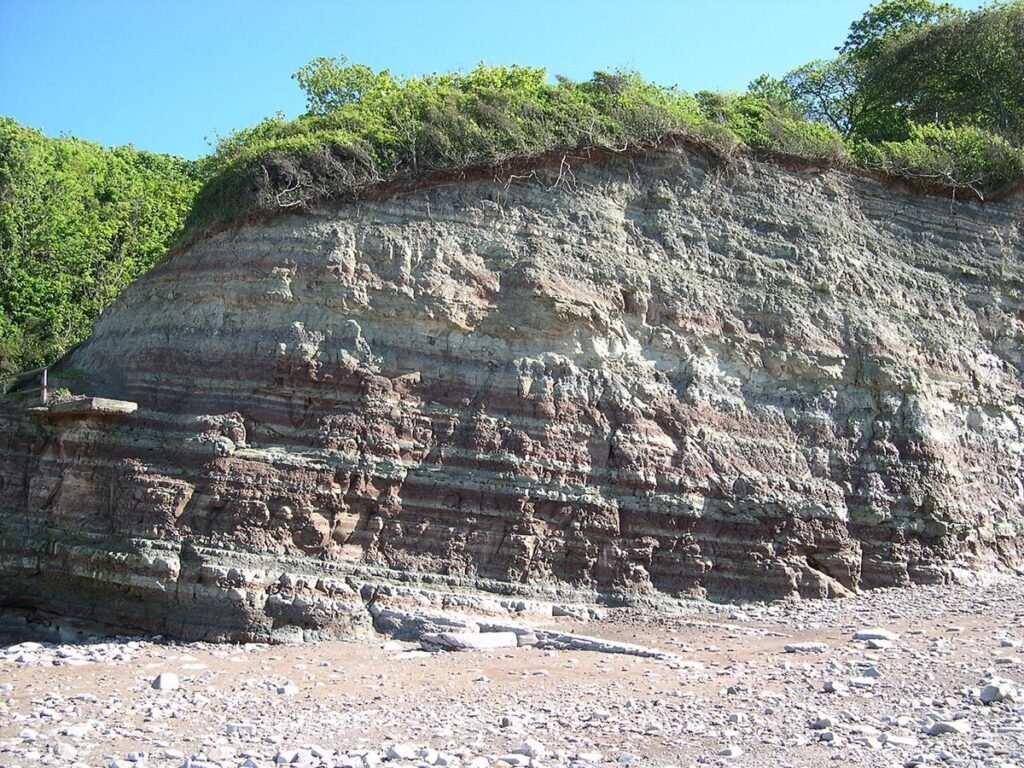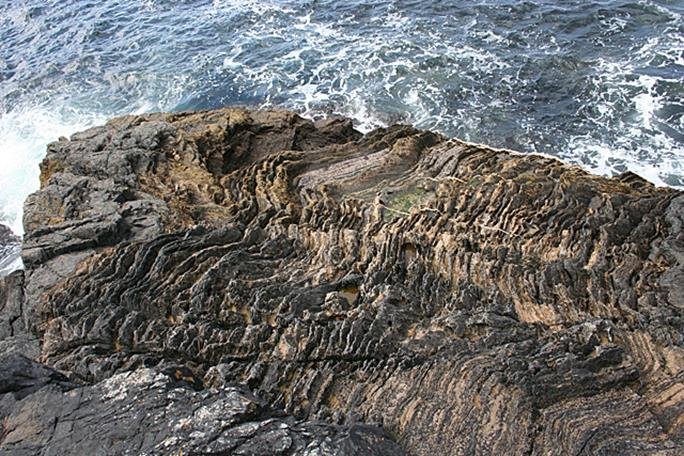The law or principle of superposition in geology states that in a sedimentary rock sequence that isn’t deformed or disturbed, any rock layer is younger than the one below it and older than the one above it.
Sedimentary rock layers form sequentially according to their age; the lowermost layer will form first and the uppermost last because gravity influences sediment deposition.
Nothing can be truer than this basic law of geology, because there is no way a lower rock layer can form later, and the one above can form earlier. You can’t build the roof of a house before laying the foundation and building the walls.
Later deformation due to Earth movements can however reverse the order of a sedimentary layer. Therefore, an emphasis on undeformed or undisturbed sedimentary sequence is necessary.
The principle of superposition is very important in relative dating since a rock layer above is younger than the one below, and vice versa. However, this only apply to undisturbed strata.

More about the principle of superposition
Nicholas Steno (1638-1686), born Niels Stensen, postulated the principle of superposition in 1669. Steno was a Danish anatomist, geologist, and priest who is also credited for the principle of cross-cutting relationships, original horizontality, and lateral continuity.
The law of superposition didn’t gain much popularity at first. However, it became popular when Willian Smith (1769–1839), an English engineer and geologist, covered it in English literature in his 1816–1819 ‘Strata Identified by Organized Fossils’ publication.
The superposition principle is based on the fact that deposited sediments lie nearly flat on earlier deposited ones. Therefore, their ages will decrease upward, and a layer beneath cannot be younger than the one above if the sedimentary rock sequence is undisturbed.
With this explanation, it is true that sedimentary rock layers become successively younger as you move up a stratigraphic column and older as you move downwards.
Last but not least, the principle of superposition also applies in lava flows and pyroclastic rocks like ash beds or tuff. However, it doesn’t apply to metamorphic rocks, as they can form at the same time if prevailing conditions are favorable.
Principle of superposition example
A quick experiment or example demonstrating the law of superposition is pouring colored molten wax layers, one top of the other, allowing each layer to solidify before pouring the next one.
Let’s assume molten wax colors are red, blue, green, yellow, black, and orange, and pour them in that order. It’s impossible to pour yellow melt beneath blue, which you poured earlier and has already solidified.
However, if you overturn the solidified colored wax layers, you can reverse the order in which you poured their melts; the youngest will be at the bottom and the oldest at the top.
Similarly, deformation and earth movements, including overturning, can also reverse the order of sedimentary rocks.
Why is the principle of superposition important?
The principle of superstation helps stratigraphers, archeologists, geologists, and other Earth scientists to know the relative ages of rock strata. Remember, relative age only tells you, which is older than the other, not the absolute age that requires radiometric dating techniques.
Secondly, by studying deformation on sedimentary strata, Earth scientists can know which past events, like folding, faulting, etc., happened and if they happened before or after certain rock layers formed.
To establish relative ages and past events, you may need the other relative dating principles like inclusion, original horizontality, lateral continuity, or fossil succession.
That is not all. Paleobotanists and paleontologists apply the law of superposition to chronologically arrange fossils in the order of their appearance. These scientists can also know how certain organisms succeeded each other by looking at their relative position in sedimentary rock sequence.
Fossils in lower strata came earlier and were less evolved than those in upper strata. The fossils found in the same strata or rock layers coexisted at the same time.
Superposition and deformed or overturned sequences
Up until now, we have discussed undeformed or undisturbed sedimentary rock sequencies.
However, most sedimentary strata are deformed, overturned, tilted, folded, or faulted by earthquakes, mountain buildings, and other tectonic activities. Additionally, magma intrusion, erosion, and chemical, human, or animal activities can disturb sedimentary rock strata.

When applying the principle of superposition on overturned, deformed or disturbed strata use fossils, and geometric and sedimentary features to know the youngest and oldest strata.
When applying the principle of superposition to overturned, deformed, or disturbed strata, use fossils and geometric and sedimentary features to know relative ages.
For instance, if sedimentary features, like ripple marks, cross-bedding, and mud-cracks, face downward, they imply the rock strata overturned. However, a coarse layer at the top doesn’t indicate an overturned strata because reverse grading in sedimentary rocks is normal.
Last but not least, a fold is younger than the folded rock strata, according to the principle of cross-cutting relationships.
Are there any limitations?
The principle of superposition only gives the relative, not absolute, age between rock layers or strata. This age gap between rock layers can be only a few years or millions of years. Therefore, you cannot know the time interval between two adjacent rock layers or strata.
A reason for a variation in age is unconformity, which is an erosional or non-depositional surface between two rock strata or layers. Erosion can remove millions of years of deposited rocks, or deposition may cease for a long time.
Finally, it is hard to guess the relative age of formation in different sedimentary basins. Is a shale or mudstone in Tuscany, Italy, the same age as the one in the UK or not?
